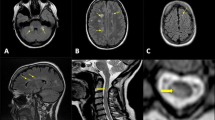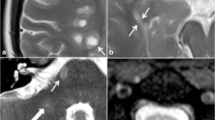Abstract
Treatment with methylprednisolone reduces the duration and severity of clinical relapses in multiple sclerosis (MS), while reducing the number of gadolinium-enhancing lesions on T1-weighted MRI. We performed serial MRI imaging after methylprednisolone treatment to see whether suppression of enhancement persists and whether related abnormalities on T2-weighted images disappear at follow-up. Thirteen patients with definite MS received a total of 31 courses of methylprednisolone over an average period of 50 weeks. Gadolinium-enhanced MRI was obtained before and after treatment, then at monthly intervals, using a standardised repositioning and imaging protocol. Two experienced readers in conference defined the number of active (gadolinium-enhancing and new or enlarging nonenhancing) lesions. We detected 609 active lesions on 195 examinations. Directly after treatment the reduction in the number of enhancing lesions was 78%, indicating restoration of the BBB and suppression of inflammation. It was uncommon for a lesion which stopped enhancing to show enhancement on a subsequent examination. No beneficial effect was observed on the rate of disappearance of related abnormalities on T2-weighted images, indicating persistent change such as oedema, cellular infiltration or demyelination. Moreover, in 89% of cases, an increase in the number of active lesions was observed before new clinical activity, if any, was observed (on average 52% earlier). MRI enabled us to demonstrate that the duration of the effect of methylprednisolone treatment is temporary (on average 9.7 weeks).
Similar content being viewed by others
References
Miller DH, Barkhof F, Berry I, Kappos L, Scotti G, Thompson AJ (1991) Magnetic resonance imaging in monitoring the treatment of multiple sclerosis: Concerted Action guidelines. J Neurol Neurosurg Psychiatry 54: 683–688
Thompson AJ, Kennard C, Swash M et al (1989) Relative efficacy of intravenous methylprednisolone and ACTH in the treatment of acute relapse in MS. Neurology 39: 969–971
Milligan NM, Newcombe R, Compston DAS (1987) A doubleblind controlled trial of high dose methylprednisolone in patients with multiple sclerosis: 1. Clinical effects. J Neurol Neurosurg Psychiatry 50: 511–516
Durelli L, Cocito D, Riccio A, Barile C, Bergamasco B, Baggio CF et al (1986) High-dose intravenous methylprednisolone in the treatment of multiple sclerosis: clinical-immunological correlations. Neurology 36: 238–243
Barkhof F, Hommes OR, Scheltens P, Valk J (1991) Quantitative MRI changes in gadolinium-DTPA enhancement after highdose intravenous methylprednisolone treatment in multiple sclerosis. Neurology 41: 1219–1222
Burnham JA, Wright RR, Dreisbach J, Murray RS (1991) The effect of high-dose steroids on MRI gadolinium enhancement in acute demyelinating lesions. Neurology 41: 1349–1354
Miller DH, Thompson AJ, Morrissey SP et al (1992) High dose steroids in acute relapses of multiple sclerosis: MRI evidence for a possible mechanism of therapeutic effect. J Neurol Neurosurg Psychiatry 55: 450–453
Poser CM, Paty DW, Scheinberg L et al (1983) New diagnostic criteria for multiple sclerosis: guidelines for research protocols. Ann Neurol 13: 227–231
Kurtzke JF (1983) Rating neurological impairment in multiple sclerosis: an expanded disability status scale (EDSS). Neurology 33: 1444–1452
Barkhof F, Scheltens P, Frequin STFM, Nauta JJP, Tas MW, Valk J, Hommes OR (1992) Relapsing-remitting multiple scleroris: sequential enhanced MR imaging vs clinical findings in determining disease activity. AJR 159: 1041–1047
Barkhof F, Valk J, Hommes OR, Scheltens P Nauta JJP (1992) Gadolinium enhancement of multiple sclerosis lesions on long TR images at 0.6 T. AJNR 13: 1257–1259
Cox DR, Oaks D (1984) Analysis of survival data. Chapman and Hall, London, pp 33–34
Troiano R, Hafstein M, Ruderman M, Dowling P, Cook S (1984) Effect of high-dose intravenous steroid administration on contrast-enhancing computed tomographic scan lesions in multiple sclerosis. Ann Neurol 15: 257–263
Barkhof F, Frequin STFM, Hommes OR et al (1992) A correlative triad of gadolinium-DTPA MRI, EDSS, and CSF-MBP in relapsing/remitting multiple sclerosis patients treated with highdose intravenous methylprednisolone. Neurology 42: 63–67
Menken M (1989) Consensus and controversy in neurologic practice. The case of steroid treatment in multiple sclerosis. Arch Neurol 46: 322
Goodin DS (1991) The use of immunosuppressive agents in the treatment of multiple sclerosis. Neurology 41: 980–985
Compston A (1988) Methylprednisolone and multiple sclerosis. Arch Neurol 45: 669–670
Thompson AJ, Miller DH, Youl B et al (1992) Serial gadolinium enhanced MRI in relapsing remitting multiple sclerosis of varying disease duration. Neurology 42: 60–63
Whitham RH, Bourdette DN (1989) Treatment of multiple sclerosis with high-dose methylprednisolone pulse therapy. Neurology 39 (S 1, abstract): 357
Polman CH, van der Wiel HE, Teule GJJ, Koetsier JC (1991) A commentary on steroid treatment in multiple sclerosis. Arch Neurol 48: 1011–1012
Wallace CJ, Seland TP, Fong TC (1992) Multiple sclerosis: the impact of MR imaging. AJR 158: 849–857
Truyen L, Gheuens J, van de Vyver FL, Parizel PM, Peersman GV, Martin JJ (1990) Improved correlation of magnetic resonance imaging (MRI) with clinical status in multiple sclerosis by use of an extensive standardized imaging protocol. J Neurol Sci 96: 173–182
Truyen L, Gheuens J, Parizel PM, van de Vyver FL, Martin JJ (1991) Long term follow-up of multiple sclerosis by standardized, non-contrast-enhanced magnetic resonance imaging. J Neurol Sci 106: 35–40
Rao SM, Leo GJ, Haughton VM, St Aubin-Fleubert P, Bernardin L (1989) Correlation of magnetic resonance imaging with neuropsychological testing in multiple sclerosis. Neurology 32: 161–166
Nagara H, Inoue T, Koga T, Kitaguchi T, Tateishi J, Goto I (1987) Formalin fixed brains are useful for magnetic resonance imaging (MRI) study. J Neurol Sci 81: 67–77
Stewart WA, Hall LD, Berry K, Paty DW (1984) Correlation between NMR scan and brain slice data in multiple sclerosis. Lancet ii: 412
Lumsden CE (1970) The neuropathology of multiple sclerosis. In: Vinken PJ, Bruyn GW (eds) Handbook of clinical neurology, vol 9. North-Holland Publishing Company, Amsterdam, pp 217–309
Author information
Authors and Affiliations
Rights and permissions
About this article
Cite this article
Barkhof, F., Tas, M.W., Frequin, S.T.F.M. et al. Limited duration of the effect of methylprednisolone on changes on MRI in multiple sclerosis. Neuroradiology 36, 382–387 (1994). https://doi.org/10.1007/BF00612124
Received:
Accepted:
Issue Date:
DOI: https://doi.org/10.1007/BF00612124




